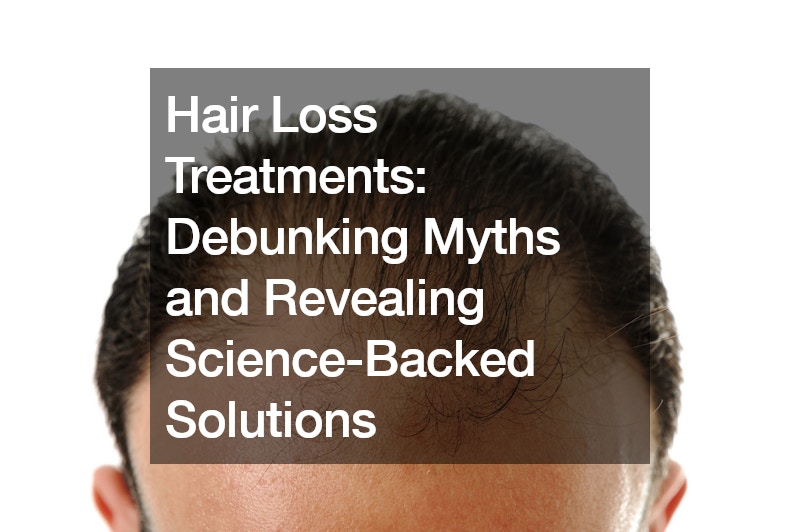
Hair loss, particularly male pattern baldness (androgenetic alopecia), is a common concern affecting millions of men worldwide. With a myriad of treatments and solutions touted in the market, it can be challenging to discern which options are genuinely effective and which are merely myths. This guide aims to clear the confusion by presenting scientifically backed treatments and debunking common misconceptions.
Understanding Male Pattern Hair Loss
Male pattern hair loss is a natural process heavily influenced by genetics. It occurs as hair follicles gradually shrink, producing thinner and shorter hairs until they eventually stop growing.
This process, while natural, can be distressing for many men.
Natural Therapies: Myth vs. Reality
A frequent question is whether natural therapies can effectively combat hair loss. It’s crucial to understand that androgenetic alopecia is a genetic condition that healthy living alone cannot fully prevent.
Dietary Supplements
There is a common belief that supplements can prevent or reverse hair loss. However, multiple studies indicate that dietary supplements do not significantly impact male pattern baldness unless there is an underlying nutritional deficiency. For instance, supplements like vitamin D and iron might help individuals with low levels of these nutrients. However, it is rare for healthy men with a balanced diet to lack these key nutrients.
Shampoos and Topical Treatments
Various shampoos claim to stop hair loss, often containing ingredients like saw palmetto, caffeine, and ketoconazole. While some low-quality trials suggest potential benefits, these studies often lack rigorous scientific validation. Many lack control groups, objective measures of hair growth, or involve too few participants to be conclusive. Therefore, these shampoos should be approached with low expectations regarding their efficacy in treating male pattern baldness.
Harmful Habits: Smoking and Hair Loss
One scientifically supported fact is that smoking can accelerate hair loss. Observational studies have consistently shown that men who smoke tend to start balding earlier and lose hair more rapidly than non-smokers. Thus, quitting smoking may help in slowing down the progression of hair loss.
Proven Hair Loss Treatments
To effectively combat hair loss, it is essential to use treatments backed by solid scientific evidence. The two most established treatments are minoxidil and finasteride.
Minoxidil
Minoxidil is a topical treatment available in foam or lotion form, applied directly to the scalp twice daily. It works by prolonging the growth phase of hair follicles, thus helping to keep them alive and stimulating hair regrowth. Approximately 99% of the medicine stays on the scalp, making it a safe option with minimal systemic side effects. The most common side effect is scalp irritation, which can often be mitigated by using the foam version.
Minoxidil has been shown to cause hair regrowth in about 15% of men and to halt further hair loss in around two-thirds of users. However, it is important to use minoxidil consistently for at least six months to accurately judge its effectiveness, as initial increased hair shedding can occur.
Finasteride
Finasteride is an oral medication that works by blocking the enzyme 5-alpha reductase, which converts testosterone to dihydrotestosterone (DHT). Lowering DHT levels reduces hair follicle miniaturization, promoting hair regrowth and preventing further hair loss. Finasteride is more effective than minoxidil, with about two-thirds of men experiencing hair regrowth and most others halting further balding.
Concerns about finasteride primarily revolve around potential sexual side effects, such as erectile dysfunction and reduced libido. Studies indicate that these side effects are relatively rare, affecting a small percentage of users. Moreover, the benefits often outweigh the risks for many men, making finasteride a viable option.
Combination Therapy
Combining minoxidil and finasteride can enhance results, particularly for those with aggressive hair loss. This dual approach tackles hair loss from different angles, providing a synergistic effect that can lead to better outcomes than either treatment alone.
Advanced Solutions: Hair Transplants and Camouflage
For men who have lost significant amounts of hair, advanced treatments like hair transplant surgery and camouflage products offer viable solutions.
Hair Transplant Surgery
Hair transplant surgery involves moving hair follicles from areas resistant to balding (usually the back and sides of the head) to the balding areas. This surgical procedure, while effective, requires a skilled surgeon to achieve natural-looking results. Hair implant or transplant solutions are often combined with treatments like finasteride or minoxidil to protect existing hair and enhance overall results.
Camouflage Products
For those who prefer non-surgical options, various camouflage products can effectively hide hair loss. These range from spray-on products to hair replacement systems, providing aesthetically pleasing results without the need for surgery.
Emerging Therapies
Emerging therapies like low-level laser therapy, platelet-rich plasma (PRP), and dutasteride show promise in treating hair loss. While more research is needed to establish their efficacy fully, these treatments represent potential future options for those struggling with androgenetic alopecia.
Final Thoughts
Researching hair loss treatments can be daunting, but focusing on scientifically backed solutions is key. Minoxidil and finasteride remain the most effective options for stabilizing hair loss and promoting regrowth. For those further along in the balding process, hair transplants and camouflage products offer viable solutions. With myths debunked and proven treatments explained, you can now make informed decisions about managing hair loss.
.

